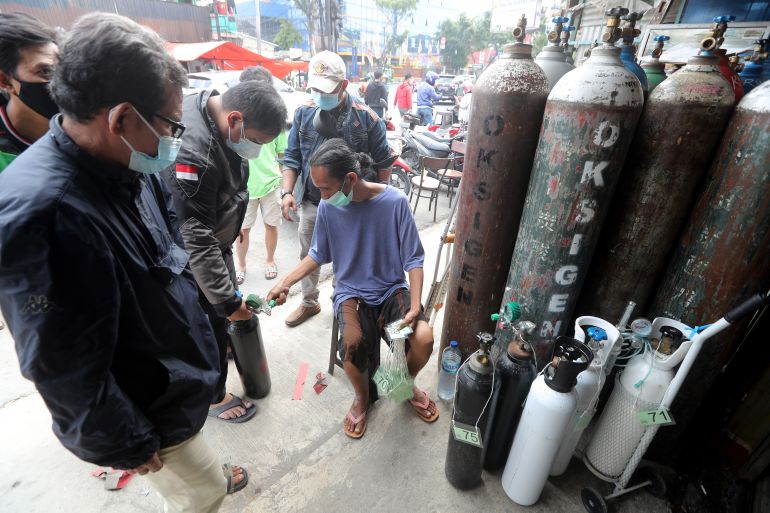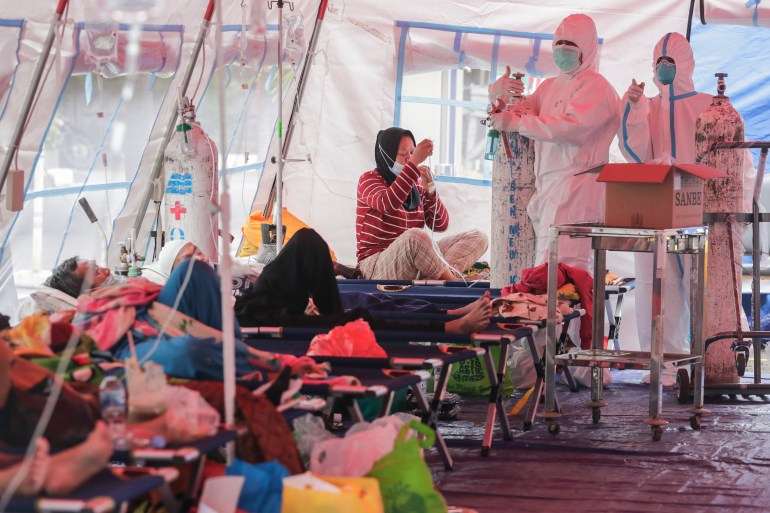‘Dying in their homes’: COVID-hit Indonesians scramble for oxygen
Citizens search desperately for oxygen to care for their loved ones at home as overwhelmed hospitals turn people away.

Jakarta/Bekasi, Indonesia – Outside a small store in South Jakarta, dozens of people line up for the chance to save the life of their loved one.
In the Indonesian capital, oxygen is an increasingly precious commodity as the country battles a relentless surge in cases of COVID-19.
Keep reading
list of 4 items‘She would have been such a good mother’
Indonesia to get US vaccine donations amid COVID emergency
Emergency curbs in Indonesia’s Java and Bali amid COVID surge
“I’m here to buy an oxygen tank for my mother, she tested positive on Sunday and we tried several hospitals but all are full,” Pinta said, as she waited in line.
“I received a list of places that sell oxygen but every single one that we went to was closed or ran out. Thank God, my friend told me to come here.”
Searching for oxygen in Jakarta in recent weeks is an unpredictable scramble – a sick person’s chances of survival can come totally down to chance, depending on whether their relative was at the right store, at the right time.
Another woman in line, Winda, says she is trying to find oxygen for her brother-in-law.
“I had trouble finding oxygen last night. I went to five places, including this store and a big medicine market but all ran out,” she said.
“We went to the health centre … they said to give oxygen at home while waiting for the hospital … but we have been waiting for two days and there’s no hospital referral.”
‘We are more worried than ever’
Twenty-nine-year-old Minanti is caring for her elderly father at home after she tried and failed to get him admitted to hospital.

He is diabetic, and has heart and kidney problems, too, putting him at increased risk from coronavirus.
But he still could not get a place in Jakarta’s crowded hospitals.
“We tried hospitals near our home … we went to the emergency unit and they said, ‘look around, it is full,’ and they told us even they have problems with oxygen,” Minanti said.
“Another hospital was also full. They have a tent in front of the building, full of sick people … we felt so scared.”
Now, like thousands of Indonesians, Minanti understands the struggle of trying to procure an oxygen cylinder during this wave of infections.
“It was super difficult to get the oxygen tank. We borrowed it and suddenly, the owner asked for it back because they, too, got COVID,” she said.
Eventually, she was able to buy an oxygen tank – but refilling it is a constant struggle.
“It was almost like a miracle to get the tank. Now, he has to have oxygen nonstop because he is constantly out of breath,” she said.
“The government should have responded fast from the beginning … now, cases have exploded. The oxygen tank is difficult to buy, and it’s difficult to refill and the hospitals are already full.”
‘We could not help them’
It is not only the general populace struggling with shortages of oxygen and medication – health professionals also told Al Jazeera they do not have enough essentials to help everyone in need.
Dr Erni Herdiani is the head of the Lemah Abang Health Clinic in Bekasi, on the outskirts of Jakarta.
“We need oxygen tanks, oxygen refill and medication. We treat severe conditions, we need medication like remdesivir and we cannot find it,” she said.
“We need to give the patients oxygen and medication. We are lacking oxygen tanks … this is beyond my expectation. So many patients need oxygen and the refilling lately is even harder.”
Dr Erni would like to buy more oxygen tanks for her clinic but says it is impossible.
“Right now, we just cannot buy it. There are no tanks. We need the government to provide it,” she said.
As hospitals in Java and other parts of Indonesia edge closer to full capacity, it is up to public health clinics to look after some of the thousands of sick people who cannot be admitted.

But Dr Erni’s team is also under pressure – there are fewer than 30 health workers at her clinic and they are monitoring more than 300 patients.
Every day, a team of roving medics from her clinic visit some of the sick.
The team has become accustomed to finding patients dead in their homes.
“Right now, there is a lot of loss [of life] at home. Sometimes, we have the report of someone who died, when we check the body, they are positive,” she said.
Dr Erni believes the official government figures, which put the death toll at more than 66,000, are an underestimate.
“It’s underreported. It is very sad because we could not help them.”
Even major hospitals are grappling with shortages or delays in receiving oxygen.
This week, at least 33 patients with severe coronavirus infections died in hospital in the city of Jogjakarta, on the island of Java, when the hospital temporarily ran out of oxygen.
A spokesperson at Dr Sardjito General Hospital told the media there had been delays from suppliers.
‘We don’t see that issue’
Dr Siti Nadia Tarmizi from the Indonesian Ministry of Health said they have already rectified logistical issues in transporting oxygen.
“What happened in Jogjakarta … because of the number of patients, their stock was running out very fast and the next shipment was only the following morning. They had limited oxygen … time was lacking there,” she said.
“We are speeding up the distribution. Previously, it was two or three days, now we are asking [them] to be ready to send within a 12- to 24-hour cycle.”

The health minister has instructed oxygen producers to redirect their efforts towards providing medical rather than industrial oxygen.
“We are working on managing the oxygen situation, in fact from our national gas industry, the capacity is still there,” Dr Nadia told Al Jazeera.
Dr Nadia said the priority is to provide oxygen for hospitals and public health facilities. She said there is no oxygen shortage.
“I don’t think that has happened. We currently don’t see that issue for health facilities, they have low numbers but we try to fill up their stock,” she said.
“Cases might increase to 50,000 or 70,000 a day. The need [for oxygen] is fulfilled but it is not at the safe level yet.”
Dr Nadia says the Ministry of Health did not anticipate such a big jump in cases.
“The main problem was, last week, we had a huge number of patients which we did not expect,” she said.
“It is very difficult to find ambulance and health facilities. Sometimes, when reaching the health facility, they already died on the way … or patients are dying in their homes.”
Fakhrur Rozi and Wildan Indrawan contributed reporting from Jakarta.